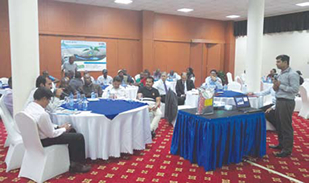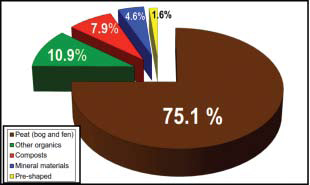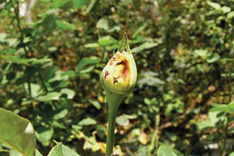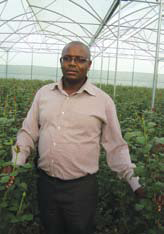Featured Past Articles
The Right Product at the Right Time
 Elgon Kenya Limited, Kenya’s leading one stop supplier of agro-inputs, has launched Zeba, a revolutionary starch-based, super absorbent. This was made possible with the company’s tie up with UPL, a global crop protection giant.
Elgon Kenya Limited, Kenya’s leading one stop supplier of agro-inputs, has launched Zeba, a revolutionary starch-based, super absorbent. This was made possible with the company’s tie up with UPL, a global crop protection giant.
Zeba is classified as a SAP (super absorbent Polymer). It is made from natural corn starch grafted to form a co-polymer. The product is capable of absorbing water within its grafted matrix to over 400 times its weight.
Speaking during the launch, Mr. Bimal Kantaria, Managing Director Elgon Kenya Ltd said that the product was the long waited saviour for the agriculture sector. “This product could not have been released at a better time than now when the country is facing serious drought due to the poor rains experienced”, he added.
Mr. Savesh Kumar, UPL Marketing Head Africa said, “Zeba is a unique technological product to counter the increasing drought-like situations and uncertainty of climate change. It will play a crucial role in Kenya’s dry land farming resulting to immediate impact”. He told growers that Zeba, a natural corn starch-based granule product, absorbs, retains and releases the water more than 400 times of its weight in the water.
Zeba forms hydrogel suspended around roots, hydrates, then releases water on demand, repeatedly. It is nontoxic, degradable; safe hence the final results are higher quality plants, using less water, making inputs more efficient.
Additionally, Zeba assists with soil aggregation and reduces soil particle movement. This provides an environment for Microbes, Increasing soil CEC. This results to retaining nutrients and increasing of the soil function in addition to environmental profile, leaching and runoff.
Growers who use Zeba will improve their soil’s physical qualities, water Holding Capacity and increase water use efficiency. Use of Zeba also results in improved soil aggregation, reducing soil bulk density and increased root penetration. Growers will also experience increased nutrient acquisition and use efficiency, and reduced surface capping.
Mr. Aruni Singh, a Manager with an herbs farm in Kitengela confirmed Zeba had enabled him cut down the use of water. “Kitengela is a relatively dry area and with the current drought, the situation has worsened. We have faced a serious shortage of water but eight months ago, I was introduced to Zeba, on trials, the Zeba treated section did not seem to suffer any production drop like I saw in other places. That means the availability of water kept the plant in a better shape through the heat. Zeba kept a more consistent supply of water in the root zones. I saw a larger plant structure, which tells me water was consistently available. Now it is part of my procurement budget”, he said.
“With launch of Zeba today and other more new products to be launched this year we will improve our kitty of brands, providing a complete basket to farmers at an affordable cost” said Mr. Baiju Kantaria, Sales and marketing Director, Elgon Kenya Ltd. He called on growers to take advantage and maximize their profits.
UPL Head of Business Africa, Mr. Nishant said that the company consistently strives to reap an excellent harvest of value for the farmers as its partner through implementation of sound crop protection strategies. He promised growers more interesting products with ability to meet specific needs of each crop and every region. In an interview with Floriculture Magazine, Mr. Andrew Tubei of Masai Farm said, “going by the data and testimonials presented, it is an good product that has come at the right time”. Same sentiments were echoed by Mr. Michael Gathage of Redlands Roses in Ruiru. Most of the farmers present seemed to agree with them.
Peat moss is partially decomposed sphagnum moss plants, which are harvested from peat bogs. While peat moss is brown, like soil, it has a different texture and weight, it is light and spongy and crumbles into tiny splinters. It is difficult to wet, but once wet it retains water like a sponge, meaning it reduces drainage of water from soil.
Peat is a mixture of decomposed plant material that has accumulated in water-saturated bogs in the absence of oxygen. Peat formation is a continuous process, with bogs typically accumulating peat at a rate of 1-2mm every year.
The rate of accumulating plant material is greatest in areas where the ambient temperature is high enough for plant growth but where the level of rainfall, specific topography of the landscape and low transpiration rates encourages water logging, limiting aerobic microbial activity which would normally break down the plant material. Such conditions are found more frequently in the northern hemisphere.
Peat moss can be purchased on its own, but it is often added as an ingredient to potting soil to lighten the soil and allow it to hold moisture better. It is often the main ingredient of soilless potting mixes. Because the bogs where peat moss is harvested are ecologically fragile, there is now a movement to limit the use of peat moss in gardening.
Canadian sphagnum peat moss is a natural, organic soil conditioner that regulates moisture and air around plant roots for ideal growing conditions. It helps to do the following;
Save Water.
• Peat retains up to 20 times its weight in moisture, and releases water slowly as plants need it.
Aerate Heavy, Clay Soil.
• Peat moss allows for proper root growth by loosening and aerating soils.
Bind Sandy Soil.
• By adding body to sandy soil, Canadian peat helps it retain moisture and nutrients.
Reduce Leaching.
• Peat moss reduces leaching of nutrients in or added to the soil, releasing them over time. This will save on fertilizer.
Protect Soil.
• Peat moss protects soil from hardening and adds organic material.
Make Better Compost.
• Peat moss speeds the composting process, reduces odours and controls air and water in the compost pile.
Peat moss decomposes slowly over several years compared to compost which typically decomposes within one year. It has a reliable pH (3.4 to 4.8); is environmentally friendly and free of insects, weeds, seeds, salts and chemicals, and represents good value (bale compression means you get approximately two bales in one!).
Peat is a very homogeneous material available in large quantities, which allows growers to have results which are predictable and reproducible.
Peat is by nature a very clean and safe material for crop production. It is produced in remote areas where there is no commercial crop production activity, so it is unlikely to contain any weeds or other contaminants. In addition, the winter time temperatures dive below minus 25 degrees, helping to kill any unwanted pathogens.
Finally, peat has a low bulk density and is easy compressible. This makes it very fuel efficient for transporting over long distances. This helps to both keep prices down for growers, and to reduce its impact on climate change.
The colour of sphagnum peat - white, brown or black, reflects its degree of decomposition, which can be measured on a scale called the von Post scale. The von Post scale classifies peats depending on the level of decomposition, and is divided into ten classes, from very slightly decomposed peat (H1-H2), slightly decomposed peat (H3-H4), medium decomposed peat (H5-H6), highly decomposed peat (H7- H8), until finally completely decomposed peat (H9-H10). For growing media, the best peats to use are those from H1 to H6.
Different peats on the von Post scale, are physically and chemically different. For example dark or “black” highly decomposed sphagnum peat has the highest water holding capacity, whereas the white sphagnum peat has the highest air capacity. Calcium and magnesium concentrations as well as pH-values also vary between the different peat types.

Peats from different sources also vary biologically, and vary in their microbial composition. Generally, blond or light-colored peats (H1-H2 on the von Post scale) are known to be very disease suppressive. This is because they can harbor high populations of ‘friendly’ microbes such as Trichoderma and Streptomyces species, which have shown to reduce the levels of pathogenic microbes in soil.
So it is evident that the degree of decomposition has a large impact on the physical, chemical and biological characteristics of peat, and depending on the crop and growing situation, different peats are selected for different growing media.
As different grades of peat are used for different purposes, once arrived at the production facility, the peat is carefully checked before further processing and turning into growing media.
Smell, purity, colour and other visually detectable and are first inspected. Other parameters are then tested by laboratory analysis including, pH, moisture content, water absorption, structural analysis, bulk density, temperature and weed tests. Only peat which passes all the tests then enters into the production facility.
Different grades, and types of peat, are then separated into bays at the production facility, and selected for specific recipes for individual growers. Various peat grades as well as specific additives such as starter fertilisers, are then accurately dosed and blended together to formulate growing media for individual customers.
Used by growers all over the world  In Europe, 90 %of the growing media used by professional growers are peat-based. In 2013, the total growing media market in EU, which includes amateur (hobby) use, was more than 34 million m3. Peat is also transported and used across the globe. From Northern Europe, peat is sent by ship to areas including the middle-east, Asia and even Australia where growers appreciate its unique properties, supporting a global horticulture industry.
In Europe, 90 %of the growing media used by professional growers are peat-based. In 2013, the total growing media market in EU, which includes amateur (hobby) use, was more than 34 million m3. Peat is also transported and used across the globe. From Northern Europe, peat is sent by ship to areas including the middle-east, Asia and even Australia where growers appreciate its unique properties, supporting a global horticulture industry.
After climbing one great hill, one only realizes that there are many more mountains to climb’. This old adage attributed to one of African greats rings true in pest management. The past few decades has seen the rise and spread of thrips in greenhouse farming, hitherto a minor pest, to become the most destructive insect pests of the greenhouses. Thrips hits growers where it hurts most! Writes Simon Kihungu
 Thrips are minute, slender insects, usually only a few millimetres long with piercingsucking- mouthparts and the ability to cause direct damage to flowers making it unmarketable for export.
Thrips are minute, slender insects, usually only a few millimetres long with piercingsucking- mouthparts and the ability to cause direct damage to flowers making it unmarketable for export.
Thrips have piercing-sucking mouthparts. They use a needle-like structure to puncture plant tissue and a second tube-like structure which is placed into the hole through which plant sap is extracted, subsequently causing direct damage to the crop.
In Flowers there are mainly two types of Thrip species that attack roses, carnations and other flowers. The western flower thrips (Franklieniela occidentalis) and Thrips tabaci also known as Onion thrip. These thrips species mainly feed on both leaves and flower petals with the majority of their damage to roses occurring throughout the growing period of the flowers.
Why Buyers Should Flock Nakuru  You might think of Nakuru as an ultimate “Cereal region” by victim of being the Kenya’s biggest producer of barley and wheat, but over the past one decade it has become famous for a rather more fragrant crop.
You might think of Nakuru as an ultimate “Cereal region” by victim of being the Kenya’s biggest producer of barley and wheat, but over the past one decade it has become famous for a rather more fragrant crop.
Nakuru is the country’s secondlargest exporter of cut flowers, 80 per cent of which are roses. It is an industry that employed about 35,000 people and generated about 25% of flower business last year. According to generated stories, Nakuru’s success comes down to its latitude: only on the equator, so the story goes, do roses grow perfectly straight. But, attractive though it sounds, this is a myth, according to researchers. “Nakuru is a great place to cultivate roses, but they are no straighter,” says Mr. Andrew Wambua, General Manager, Molo River Farm. “The real advantage is that you get natural light all year round, so you can grow anytime and don’t have to use a lot of artificial illumination.”
“Bringing Colour to the Lives of Children and Communities”
Dutch Flower Foundation supports Local projects in Africa
 The 30 Dutch Flower Group companies operate worldwide, including in Kenya, Zimbabwe, Ethiopia and Uganda. This globally operating horticulture concern from the Netherlands is keen to put something back in the local communities in areas where they operate. When Dutch Flower Group was established in 1999, the management board immediately set up its own foundation, through which Dutch Flower Group supports a range of local projects, including in Africa. “The establishment of Dutch Flower Foundation ensured that from the start in 1999 we were able to support projects financially,” according to Dutch Flower Foundation’s chairman Boudewijn Rip. “We do this mainly in areas where the growers we work with are situated. We also support projects in areas where Dutch Flower Group companies are situated and in regions where our employees live.”
The 30 Dutch Flower Group companies operate worldwide, including in Kenya, Zimbabwe, Ethiopia and Uganda. This globally operating horticulture concern from the Netherlands is keen to put something back in the local communities in areas where they operate. When Dutch Flower Group was established in 1999, the management board immediately set up its own foundation, through which Dutch Flower Group supports a range of local projects, including in Africa. “The establishment of Dutch Flower Foundation ensured that from the start in 1999 we were able to support projects financially,” according to Dutch Flower Foundation’s chairman Boudewijn Rip. “We do this mainly in areas where the growers we work with are situated. We also support projects in areas where Dutch Flower Group companies are situated and in regions where our employees live.”
By Wycliffe N. Sovari
Technically speaking, “power” is the ability to do work ……it all started with the invention of the bulb, we had the telephone by Alexander Graham Bell (18th CENTURY) and since time immemorial; Electronics and Electricity are part and parcel of man’s life all over the globe. Engineering, technology, innovation, applied science and agriculture are thus interdependent and inseparable in our normal day-to-day activities.

Narrowing down to Power as a utility in farming and for that case electricity we really need to check on the merits and demerits as farmers and see how best and cheaply we can utilize power?
In our discussion we shall compare and advice the now; “Power-conscious farmer” on HEP (Hydro-Electric Power), Solar Power, Geothermal, Biogas Power and a little hint on rarely discussed sources such as Nuclear power. Nevertheless, our concentration will feature mostly on natural and renewable sources of energy because of their natural abundance and economics of operation.
In my line of work I visit hundreds of flower farms a year; the flourishing, the ticking over, and the ones in dire straits. A lot of my hard work is dealing with farms that suddenly run into problems. “Ruth, please come and visit our farm as soon as possible, our production has suddenly dropped to half” is a common call writes Ruth Vaughan, Technical Director, CropNuts

My advice to flower farmers on the critical issues in plant nutrition in floriculture would be as follows:-
Start with the basics and know what you are dealing with. A solid ‘risk’ assessment before you even buy the farm is recommended. Dig soil pits to look for soil layers, compaction zones, soil depth, underground water or solid rock. Is the soil type even across the farm? Where does the water go when it rains? Does it hail in this area? What are the day/night temperatures and what is the annual rainfall? Look at the aspect and slope of the farm, will you need special drip lines? Do a complete soil analysis, nematode count, pathology screen and irrigation water analysis. Now you know what you are dealing with and can work out the economics. It’s better to get a shock now than after your investment.
Read more: Critical Issues in Plant Nutrition in Floriculture


